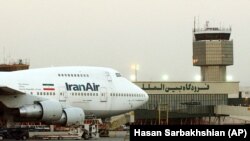Reimposed U.S. sanctions on Iran are making it more difficult and expensive for average Iranians to travel abroad, and an increase in Iranian asylum claims in Europe could see further restrictions imposed.
The Serbian government announced earlier this month it would re-establish visa requirements for Iranian nationals in an about-face from their decision last year to drop the visa requirement in order to boost tourism between Tehran and Belgrade.
According to Serbian Interior Minister Nebojsa Stefanovic, the Iranian visitors to Serbia have “misused” visa-free travel as a way to seek asylum in Europe.
Currently in negotiations for future membership in the European Union, Serbia often serves as a gateway to the European Union for refugees, asylum seekers, and migrants. As a result, up to 1,100 Iranians have sought asylum in Serbia this year so far.
Following the 2016 repeal of many of the economic sanctions against Iran as part of the nuclear deal, Western companies began preparing a variety of investments in Iran, including an increase in international flights to and from Iran. Etihad Airline, for example, increased the number of flights between their hub Abu Dhabi and Tehran from three times a week to daily.
The expansion of air travel increased the influx of international tourists to Iran while also making it more affordable for Iranians to travel abroad more frequently.
In 2017, Iran recorded 9.2 million departures, a 38.5 percent increase from 2016. Similarly, while some European destinations are still either too expensive or inaccessible due to strict visa measures, Turkey became a hotspot for Iranian tourism, with the eastern Anatolian city of Van, about an hour from the Iranian border, recording over 388 thousand visitors in 2017.
However, the newly reimposed U.S. sanctions have already taken their toll on the Iranian tourism sector. Compared to last year, the number of Iranians traveling to other countries in the past 6 months has fallen by 13 percent. Many Western airlines have also announced the termination of their services to Iran, namely British Airways, who have ended their London to Tehran service, citing a lack of commercial viability.
Iran is in the midst of a economic crisis caused in part by U.S. sanctions, and the lack of international flights will make air travel even more unaffordable for average Iranian travelers. The increase of the departure tax paid by all Iranians flying abroad from 20 dollars to 60 dollars will also add to the difficulty.
The new obstacles to travel signal a return to the state of affairs for Iranians prior to the repeal of international sanctions, when international travel was a luxury reserved for the wealthy.
In the meantime, political, economic, and cultural issues hinder growth in incoming tourism to Iran. Tourists have very little to do in the evening after a day of sightseeing, as alcohol and mixed gatherings are prohibited. Security concerns also cause tourists to think twice before visiting Iran.







